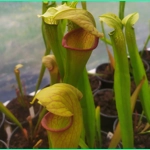Sarracenia rubra subsp. jonesii
Sarracenia rubra subsp. jonesii looks very much like a large version of
Sarracenia rubra subsp. rubra. The flowers smell sweet and have a hint of the raspberry smell similar to that of
S. rubra subsp. rubra flowers. As is typical for the subspecies the spring leaves are kind of floppy, with a large midrib. It is speculated that this is to maximise the surface area for photosynthesis in spring, carnivory becoming really important only in summer.
Sarracenia rubra subsp. jonesii is endemic to 10 mountain bogs on the border between North (Buncombe, Henderson, Transylvania Co) and South (Greenville, Pickens Co) Carolina. It's a bog plant, but sometimes occurs at sites called "cataract bogs." These are places where the surface water sheets out over huge, sloping granite slabs. The plants kling to edges and any holdfast on these slabs.
It is extremely endangered in the wild and listed as such on the Appendix I of CITES. The biggest problems are changes in hidrology of its habitat and poaching from nature. For example, every single anthocyanin-free plant has been stolen from the wild by collectors.
Sarracenia rubra subsp. jonesii is part of the S. rubra complex. Taxonomy of this complex is rather is rather complicated. Currently, there are six subspecies, their relationships and taxonomic level are described differently by different authors. Personally I think Barry Rice makes a good point grouping the taxons correspondingly to river catchments in which they occur. However the final word would of course be a genetic analysis.
- S. rubra subsp.
rubra- S. rubra subsp.
jonesii [=
S. jonesii]
- S. rubra subsp.
gulfensis- S. rubra subsp.
viatorum- S. rubra subsp.
alabamensis [=
S. alabamensis]
- S. rubra subsp.
wherryi [=
S. alabamensis subsp.
wherryi]
The range of the
S. rubra complex extends from southern Mississippi, through southern Alabama, the Florida panhandle and Georgia, to the coastal plains of North Carolina and South Carolina.
Sarracenia rubra is generally smaller and narrower than most species, usually not exceeding 65 cm in height.
Sarracenia rubra is generally clump-forming.
We offer plants of M/L size: plants that will flower in the coming season, with 1 large growing and with some side-shoots.
 AED
AED AFN
AFN ALL
ALL AMD
AMD ANG
ANG AOA
AOA ARS
ARS AUD
AUD AWG
AWG AZN
AZN BAM
BAM BBD
BBD BDT
BDT BGN
BGN BHD
BHD BIF
BIF BMD
BMD BND
BND BOB
BOB BRL
BRL BSD
BSD BTN
BTN BWP
BWP BYN
BYN BZD
BZD CAD
CAD CDF
CDF CHF
CHF CLF
CLF CLP
CLP CNH
CNH CNY
CNY COP
COP CRC
CRC CUC
CUC CUP
CUP CVE
CVE CZK
CZK DJF
DJF DKK
DKK DOP
DOP DZD
DZD EGP
EGP ERN
ERN ETB
ETB FJD
FJD FKP
FKP GBP
GBP GEL
GEL GGP
GGP GHS
GHS GIP
GIP GMD
GMD GNF
GNF GTQ
GTQ GYD
GYD HKD
HKD HNL
HNL HRK
HRK HTG
HTG HUF
HUF IDR
IDR ILS
ILS IMP
IMP INR
INR IQD
IQD IRR
IRR ISK
ISK JEP
JEP JMD
JMD JOD
JOD JPY
JPY KES
KES KGS
KGS KHR
KHR KMF
KMF KPW
KPW KRW
KRW KWD
KWD KYD
KYD KZT
KZT LAK
LAK LBP
LBP LKR
LKR LRD
LRD LSL
LSL LYD
LYD MAD
MAD MDL
MDL MGA
MGA MKD
MKD MMK
MMK MNT
MNT MOP
MOP MRU
MRU MUR
MUR MVR
MVR MWK
MWK MXN
MXN MYR
MYR MZN
MZN NAD
NAD NGN
NGN NIO
NIO NOK
NOK NPR
NPR NZD
NZD OMR
OMR PAB
PAB PEN
PEN PGK
PGK PHP
PHP PKR
PKR PLN
PLN PYG
PYG QAR
QAR RON
RON RSD
RSD RUB
RUB RWF
RWF SAR
SAR SBD
SBD SCR
SCR SDG
SDG SEK
SEK SGD
SGD SHP
SHP SLE
SLE SLL
SLL SOS
SOS SRD
SRD SSP
SSP STD
STD STN
STN SVC
SVC SYP
SYP SZL
SZL THB
THB TJS
TJS TMT
TMT TND
TND TOP
TOP TRY
TRY TTD
TTD TWD
TWD TZS
TZS UAH
UAH UGX
UGX USD
USD UYU
UYU UZS
UZS VES
VES VND
VND VUV
VUV WST
WST XAF
XAF XCD
XCD XCG
XCG XOF
XOF XPF
XPF YER
YER ZAR
ZAR ZMW
ZMW ZWG
ZWG ZWL
ZWL Slovenščina
Slovenščina




















